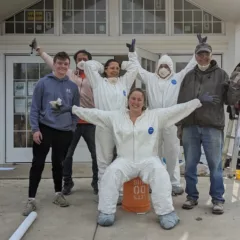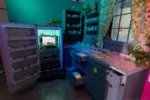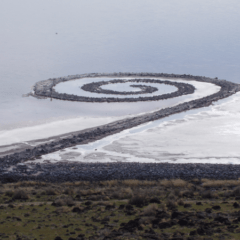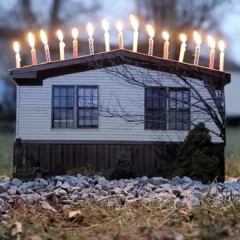By Becky Hunter
To access Jeff Williams’ pair of low-fi dissolving machines in Grizzly Grizzly’s appropriately-industrial, paint-pocked space, you must squeeze past a waist-high concrete beam held horizontal by a hydraulic jack under it and by its attachment to the wall and to a single white support beam in the gallery. Behind the concrete barrier at the center of the small, rear area sits Rebar Corrosion, four separate clear plastic or glass tanks – like clunky, oversized test-tubes – containing tap water, salt water, vinegar and lemon juice. The tubes sit atop a white concrete “plinth” that emphasizes the construction’s sculptural roots. One-foot lengths of steel rebar stand in the acidic or alkaline liquids and fizz and flake into the containers. There is salty-looking fuzz at the jars’ edges.
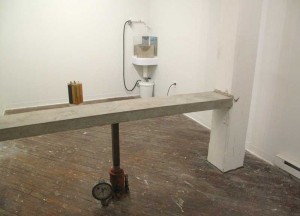
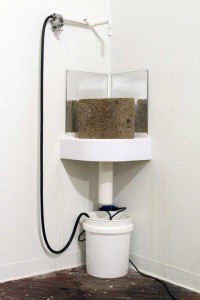
The entire exhibition is set up as if an experiment. Indeed, Williams’ handling of time, material and process fits contemporary discussion on the overlaps and gaps between artistic and scientific knowledge, such as in the current London-based exhibition Theory of Everything at Core Gallery. [Ed: or the recent science & art exhibit, VAAST at Little Berlin.] But the show also harks back to post-minimalist concerns of the late 1960s and early 1970s. Echoing Robert Smithson’s Corner Mirror with Coral (1969), Erosion Fountain is displayed in the gallery’s back corner in front of a group of mirrors that double the work’s white shelf and damp, disintegrating adobe brick. As the brick gradually dematerializes – by the action of water channeled through the flexible, black hose of an electronic pump – so the room’s physical boundaries are made visually porous with the addition of reflective surfaces clouded with water droplets.
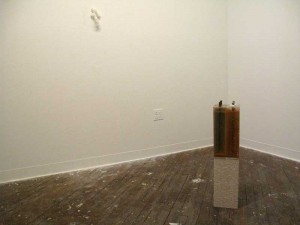
The industrial-lab aesthetic recalls a much larger-scale process piece by Robert Morris, Untitled [Concrete, Timbers & Steel], installed at the Whitney in 1970. Morris hired construction workers decked in hard hats to push, or “spill”, unrefined manufacturing components around in a series of destructive actions, using an outsized conveyor system. This resulted in damage and stress upon the museum’s reinforced floor. In Williams’ Concrete Compression, the steel-reinforced concrete slab that all but bars entrance to the gallery’s rear two thirds is pressured with an antiquated hydraulic jack that will bend the material to its breaking point. Red pencil lines trace fine cracks on its surface: delicate, incremental markers typically used by engineers to denote stress cracks.
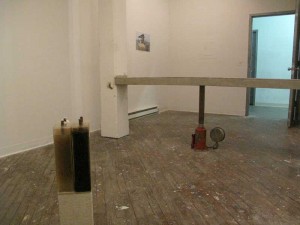
Williams’ low-key installation is, as a whole, less explicitly dangerous than Morris’s, relying as it does upon suspense rather than awe for its emotional impact. Yet each slowly deconstructing work-in-progress develops themes of artistic labor that are equally relevant now as in the 1970s. In this case, fairly-accessible equipment and simple chemical processes take on the effort — that traditionally belongs more directly to the artist — of transforming metal and stone. Perhaps also brought into question is the ongoing usefulness of fine art in a world where technology promises so much.
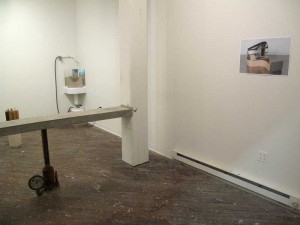
Finally, it is in the nature of process-based work that it “exists” through photography and text after the fact. One may view Morris’s Untitled, for example, through archived, silhouetted action-shots of the construction crew. At Grizzly Grizzly, Williams includes a pinned-up digital print from a prior project at UT Austin Architecture Materials Lab. This static record somehow completes the progression from wholeness, through stress, to dissolution that is in play here.
The show closed July 30th .
–Becky Hunter, who recently moved to Philadelphia from London, writes about art on her blog and at Art Papers, Sculpture and White Hot Magazine.


